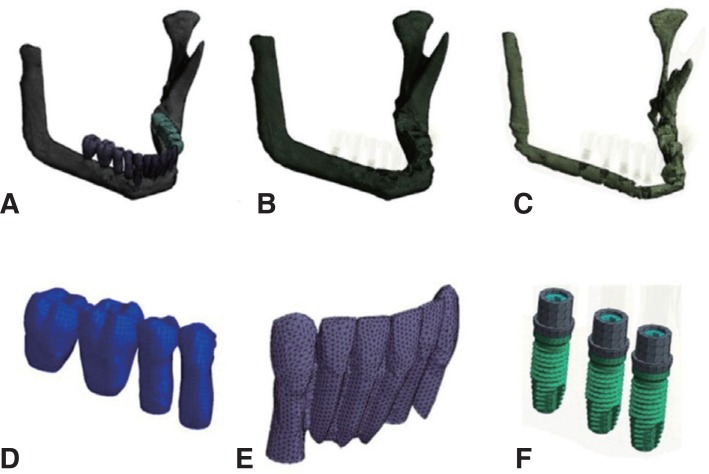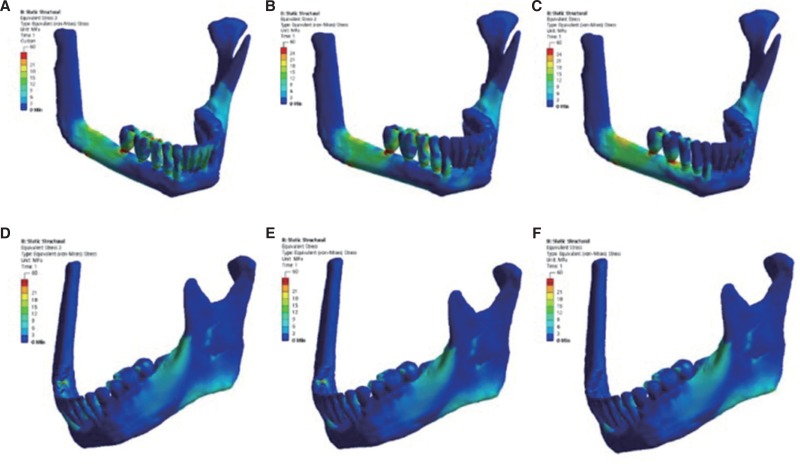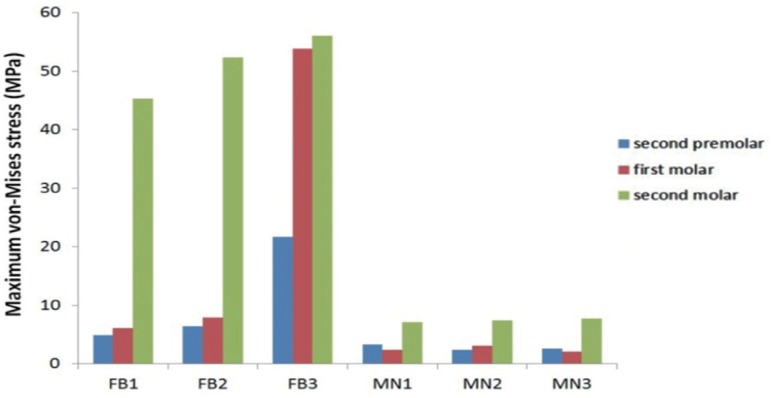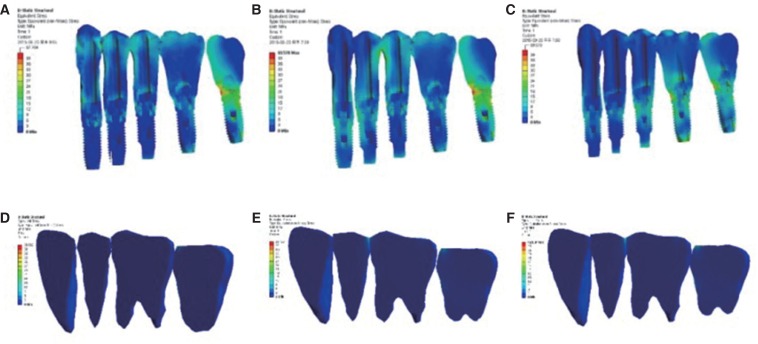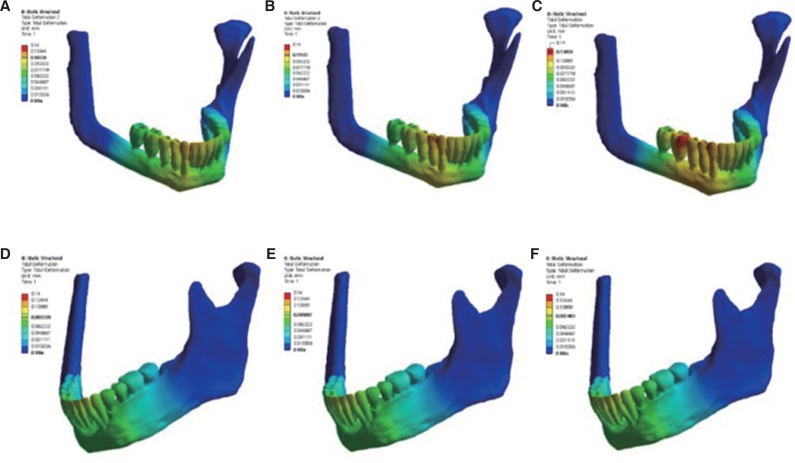J Adv Prosthodont.
2018 Apr;10(2):138-146. 10.4047/jap.2018.10.2.138.
Three-dimensional finite element analysis of the splinted implant prosthesis in a reconstructed mandible
- Affiliations
-
- 1Department of Prosthodontics, School of Dentistry, Seoul National University, Seoul, Republic of Korea.
- 2Dental Research Institute and Department of Prosthodontics, School of Dentistry, Seoul National University, Seoul, Republic of Korea. proskwon@snu.ac.kr
- KMID: 2409634
- DOI: http://doi.org/10.4047/jap.2018.10.2.138
Abstract
- PURPOSE
The purpose of this study was to analyze the effects of the splinted implant prosthesis in a reconstructed mandible using three-dimensional finite element analysis.
MATERIALS AND METHODS
Three-dimensional finite element models were generated from a patient's computed tomography data. The patient had undergone partial resection of the mandible that covered the area from the left canine to the right condyle. The mandible was reconstructed using a fibula bone graft and dental implants. The left mandibular premolars and molars remained intact. Three types of models were created. The implant-supported prosthesis was splinted and segmented into two or three pieces. Each of these models was further subcategorized into two situations to compare the stress distribution around normal teeth and implants. Oblique loading of 300 N was applied on both sides of the mandible unilaterally. The maximum von Mises stress and displacement of the models were analyzed.
RESULTS
The stress distribution of the natural mandible was more uniform than that of the reconstructed fibula. When the loading was applied to the implant prosthesis of reconstructed fibula, stress was concentrated at the cortical bone around the neck of the implants. The three-piece prosthesis model showed less uniform stress distribution compared to the others. Displacement of the components was positively correlated with the distance from areas of muscle attachment. The three-piece prosthesis model showed the greatest displacement.
CONCLUSION
The splinted implant prosthesis showed a more favorable stress distribution and less displacement than the separated models in the reconstructed mandible.
MeSH Terms
Figure
Cited by 1 articles
-
Influence of tongue pressure on the obturator prosthesis for soft palate defects: a 3D-FEA study
Aein Mon, Mi-El Kim, Young-Jun Lim, Myung-Joo Kim, Ho-Beom Kwon
J Dent Rehabil Appl Sci. 2023;39(2):61-68. doi: 10.14368/jdras.2023.39.2.61.
Reference
-
1. Flemming AF, Brough MD, Evans ND, Grant HR, Harris M, James DR, Lawlor M, Laws IM. Mandibular reconstruction using vascularised fibula. Br J Plast Surg. 1990; 43:403–409. PMID: 2393766.
Article2. Komisar A. The functional result of mandibular reconstruction. Laryngoscope. 1990; 100:364–374. PMID: 2181219.
Article3. August M, Tompach P, Chang Y, Kaban L. Factors influencing the long-term outcome of mandibular reconstruction. J Oral Maxillofac Surg. 2000; 58:731–737. PMID: 10883687.
Article4. Chang YM, Santamaria E, Wei FC, Chen HC, Chan CP, Shen YF, Hou SP. Primary insertion of osseointegrated dental implants into fibula osteoseptocutaneous free flap for mandible reconstruction. Plast Reconstr Surg. 1998; 102:680–688. PMID: 9727431.
Article5. Hidalgo DA. Fibula free flap: a new method of mandible reconstruction. Plast Reconstr Surg. 1989; 84:71–79. PMID: 2734406.6. Zlotolow IM, Huryn JM, Piro JD, Lenchewski E, Hidalgo DA. Osseointegrated implants and functional prosthetic rehabilitation in microvascular fibula free flap reconstructed mandibles. Am J Surg. 1992; 164:677–681. PMID: 1463123.
Article7. Kuiper JH, Huiskes R. The predictive value of stress shielding for quantification of adaptive bone resorption around hip replacements. J Biomech Eng. 1997; 119:228–231. PMID: 9285333.
Article8. Sugiura T, Horiuchi K, Sugimura M, Tsutsumi S. Evaluation of threshold stress for bone resorption around screws based on in vivo strain measurement of miniplate. J Musculoskelet Neuronal Interact. 2000; 1:165–170. PMID: 15758514.9. Hoshaw SJ, Brunski JB, Cochran GVB. Mechanical loading of Brånemark implants affects interfacial bone modeling and remodeling. Int J Oral Maxillofac Implants. 1994; 9:345–360.10. Brunski JB. In vivo bone response to biomechanical loading at the bone/dental-implant interface. Adv Dent Res. 1999; 13:99–119. PMID: 11276755.
Article11. Kopp CD. Overdentures and osseointegration. Case studies in treatment planning. Dent Clin North Am. 1990; 34:729–739. PMID: 2227043.12. Geng JP, Tan KB, Liu GR. Application of finite element analysis in implant dentistry: a review of the literature. J Prosthet Dent. 2001; 85:585–598. PMID: 11404759.
Article13. Teixeira ER, Sato Y, Akagawa Y, Shindoi N. A comparative evaluation of mandibular finite element models with different lengths and elements for implant biomechanics. J Oral Rehabil. 1998; 25:299–303. PMID: 9610858.
Article14. Meijer HJ, Starmans FJ, Steen WH, Bosman F. A three-dimensional, finite-element analysis of bone around dental implants in an edentulous human mandible. Arch Oral Biol. 1993; 38:491–496. PMID: 8343071.
Article15. Korioth TW, Johann AR. Influence of mandibular superstructure shape on implant stresses during simulated posterior biting. J Prosthet Dent. 1999; 82:67–72. PMID: 10384165.
Article16. Tie Y, Wang DM, Ji T, Wang CT, Zhang CP. Three-dimensional finite-element analysis investigating the biomechanical effects of human mandibular reconstruction with autogenous bone grafts. J Craniomaxillofac Surg. 2006; 34:290–298. PMID: 16781160.
Article17. Nagasao T, Kobayashi M, Tsuchiya Y, Kaneko T, Nakajima T. Finite element analysis of the stresses around endosseous implants in various reconstructed mandibular models. J Craniomaxillofac Surg. 2002; 30:170–177. PMID: 12220996.
Article18. Kregzde M. A method of selecting the best implant prosthesis design option using three-dimensional finite element analysis. Int J Oral Maxillofac Implants. 1993; 8:662–673. PMID: 8181829.19. Bal BT, Cağlar A, Aydin C, Yilmaz H, Bankoğlu M, Eser A. Finite element analysis of stress distribution with splinted and nonsplinted maxillary anterior fixed prostheses supported by zirconia or titanium implants. Int J Oral Maxillofac Implants. 2013; 28:e27–e38. PMID: 23377079.
Article20. Schiffleger BE, Ziebert GJ, Dhuru VB, Brantley WA, Sigaroudi K. Comparison of accuracy of multiunit one-piece castings. J Prosthet Dent. 1985; 54:770–776. PMID: 3908654.
Article21. Zarone F, Apicella A, Nicolais L, Aversa R, Sorrentino R. Mandibular flexure and stress build-up in mandibular fullarch fixed prostheses supported by osseointegrated implants. Clin Oral Implants Res. 2003; 14:103–114. PMID: 12562372.
Article22. Alvarez-Arenal A, Brizuela-Velasco A, DeLlanos-Lanchares H, Gonzalez-Gonzalez I. Should oral implants be splinted in a mandibular implant-supported fixed complete denture? A 3-dimensional-model finite element analysis. J Prosthet Dent. 2014; 112:508–514. PMID: 24560983.
Article23. Maezawa N, Shiota M, Kasugai S, Wakabayashi N. Three-dimensional stress analysis of tooth/lmplant-retained long-span fixed dentures. Int J Oral Maxillofac Implants. 2007; 22:710–718. PMID: 17974104.24. Dittmer MP, Kohorst P, Borchers L, Stiesch-Scholz M. Finite element analysis of a four-unit all-ceramic fixed partial denture. Acta Biomater. 2009; 5:1349–1355. PMID: 19117821.
Article25. Rees JS, Jacobsen PH. Elastic modulus of the periodontal ligament. Biomaterials. 1997; 18:995–999. PMID: 9212195.
Article26. Sakaguchi RL, Borgersen SE. Nonlinear contact analysis of preload in dental implant screws. Int J Oral Maxillofac Implants. 1995; 10:295–302. PMID: 7615325.27. Curtis DA, Plesh O, Miller AJ, Curtis TA, Sharma A, Schweitzer R, Hilsinger RL, Schour L, Singer M. A comparison of masticatory function in patients with or without reconstruction of the mandible. Head Neck. 1997; 19:287–296. PMID: 9213107.
Article28. Curtis DA, Plesh O, Hannam AG, Sharma A, Curtis TA. Modeling of jaw biomechanics in the reconstructed mandibulectomy patient. J Prosthet Dent. 1999; 81:167–173. PMID: 9922429.
Article29. O'Mahony AM, Williams JL, Spencer P. Anisotropic elasticity of cortical and cancellous bone in the posterior mandible increases peri-implant stress and strain under oblique loading. Clin Oral Implants Res. 2001; 12:648–657. PMID: 11737110.30. Bähr W, Stoll P, Wächter R. Use of the “double barrel” free vascularized fibula in mandibular reconstruction. J Oral Maxillofac Surg. 1998; 56:38–44. PMID: 9437980.
Article31. Sulik WD, White JT. Modification of stresses surrounding abutment teeth for fixed partial dentures induced by various levels of periodontal support: a photoelastic study. J Prosthet Dent. 1981; 46:32–35. PMID: 7024515.
Article32. Yang HS, Thompson VP. A two-dimensional stress analysis comparing fixed prosthodontic approaches to the tilted molar abutment. Int J Prosthodont. 1991; 4:416–424. PMID: 1811637.33. Poiate IA, de Vasconcellos AB, de Santana RB, Poiate E. Three-dimensional stress distribution in the human periodontal ligament in masticatory, parafunctional, and trauma loads: finite element analysis. J Periodontol. 2009; 80:1859–1867. PMID: 19905956.
Article34. Frost HM. Perspectives: bone's mechanical usage windows. Bone Miner. 1992; 19:257–271. PMID: 1472896.
Article35. Hansson S. A conical implant-abutment interface at the level of the marginal bone improves the distribution of stresses in the supporting bone. An axisymmetric finite element analysis. Clin Oral Implants Res. 2003; 14:286–293. PMID: 12830797.36. Isidor F. Influence of forces on peri-implant bone. Clin Oral Implants Res. 2006; (17 Suppl 2):8–18.
Article37. Guichet DL, Yoshinobu D, Caputo AA. Effect of splinting and interproximal contact tightness on load transfer by implant restorations. J Prosthet Dent. 2002; 87:528–535. PMID: 12070516.
Article38. Clelland NL, Seidt JD, Daroz LG, McGlumphy EA. Comparison of strains for splinted and nonsplinted implant prostheses using three-dimensional image correlation. Int J Oral Maxillofac Implants. 2010; 25:953–959. PMID: 20862409.39. Stoumpis C, Kohal RJ. To splint or not to splint oral implants in the implant-supported overdenture therapy? A systematic literature review. J Oral Rehabil. 2011; 38:857–869. PMID: 21480943.
Article40. Barão VA, Delben JA, Lima J, Cabral T, Assunção WG. Comparison of different designs of implant-retained overdentures and fixed full-arch implant-supported prosthesis on stress distribution in edentulous mandible-a computed tomography-based three-dimensional finite element analysis. J Biomech. 2013; 46:1312–1320. PMID: 23518207.
- Full Text Links
- Actions
-
Cited
- CITED
-
- Close
- Share
- Similar articles
-
- ANALYSIS OF THE FIT IN THE IMPLANT PROSTHESIS USING LASER DISPLACEMENT METER AND THREE-DIMENSIONAL FINITE ELEMENT METHOD
- Three-dimensional finite element analysis of implant-supported crown in fibula bone model
- Three dimensional finite element stress analysis of implant prosthesis according to the different fixture locations and angulations
- Three-dimensional finite element analysis on stress distribution of the mandibular implant-supported cantilever prostheses depending on the designs
- Finite Element Analysis of Stress Distribution on Telescopic System for Mandibular Implant Supported Overdenture

